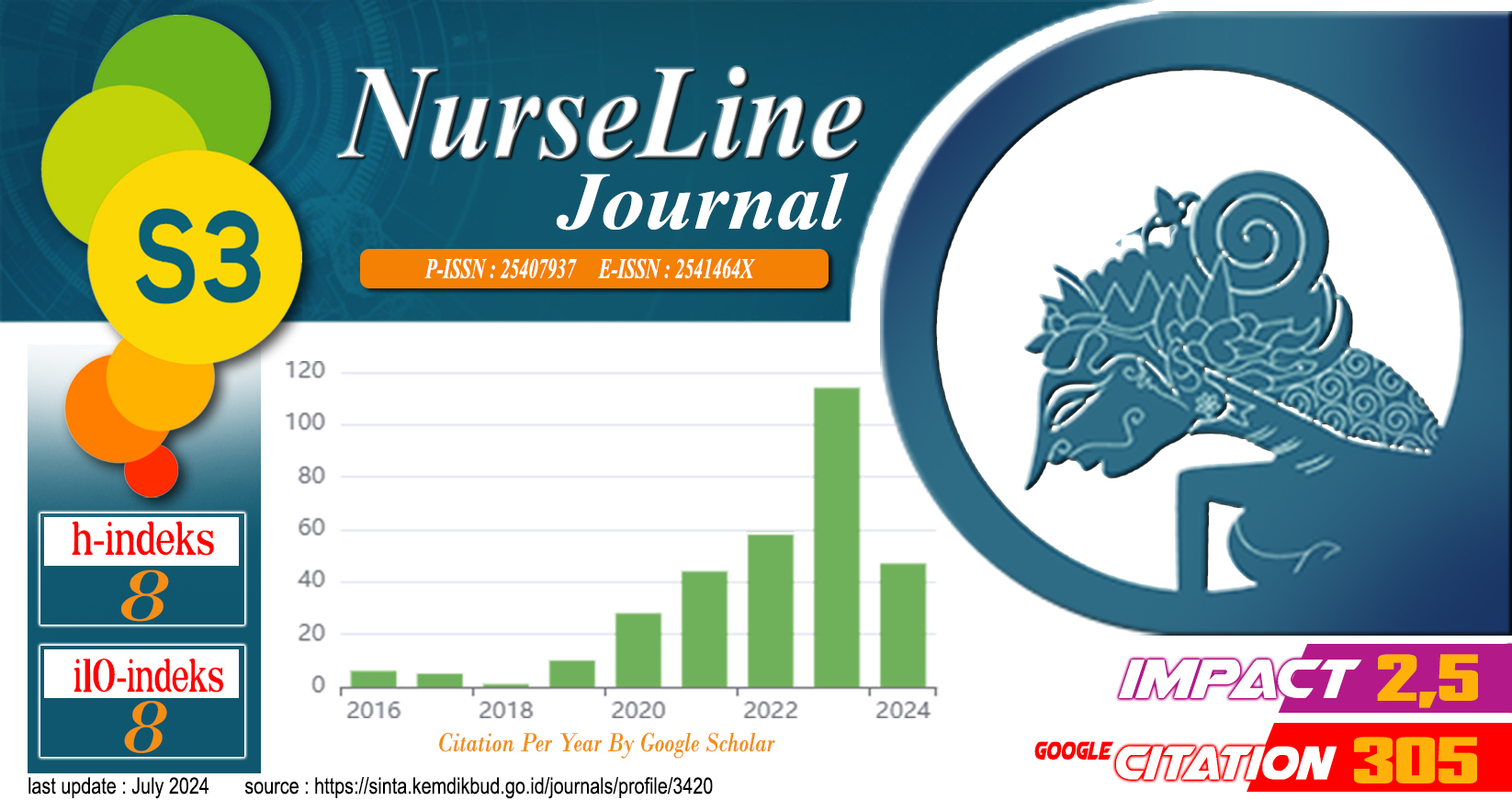Validity and Reliability of Critical Care Family Needs Inventory (CCFNI) in Indonesian Version
Abstract
Family-centered care (FCC) in intensive care as a family-based care approach has been developed for a long time, but this development in Indonesia is still not optimally created. The FCC needs basic data about the needs of the family who are caring for it, so the need for the family can be identified therefore nursing intervention can be done optimally. One measure that has been developed to assess family needs is Critical Care Family Needs Inventory (CCFNI). The purpose of this study was to analyze the CCFNI questionnaire in Indonesian version. This study tried to test the questionnaire through several steps translation into Indonesian, validity testing in the form of validity content documents (CVI) and construct validity and reliability testing. The results of the CVI test on 45 Indonesian language CCFNI questionnaire statements found that the CVI value was in the range 0.6-0.9 obtained 36 valid statement items, while the results of the construct validity test were found to be valid. Reliability test results obtained an alpha value of 0.97 which means it is very reliable. The conclusion is that the Indonesian version of the CCFNI questionnaire which is translated into Kebutuhan Keluarga Pasien di Ruang Perawatan Intensif (K3PI) is valid and reliable.
References
Cameron, J. I., Chu, L. M., Matte, A., Tomlinson, G., Chan, L., Thomas, C., … Herridge, M. S. (2016). One-Year Outcomes in Caregivers of Critically Ill Patients. New England Journal of Medicine, 374(19), 1831–1841. https://doi.org/10.1056/NEJMoa1511160
Carretero-dios, H., & Pérez, C. (2007). Standards for the development and review of instrumental studies : Considerations about test selection in psychological research. International Journal of Clinical and Health Psychology, 7(3), 863–882. Retrieved from papers3://publication/uuid/3390D80E-F5D1-47AD-968D-56E6A29F6647
Chien, W.-T., Ip, W.-Y., & Lee, I. Y. . (2005). Psychometric Properties of a Chinese Version of the Critical Care Family Needs Inventory. Research in Nursing & Health, 28, 474–487. https://doi.org/10.1002/nur
Davidson, J. E., & Strathdee, S. A. (2018). The future of family-centred care in intensive care. Intensive and Critical Care Nursing. https://doi.org/10.1016/j.iccn.2018.03.003
Dharmalingam, T. K., Kamaluddin, M. R., & Hassan, S. K. (2016). Factorial validation and psychometric properties establishment of malay version critical care family need inventory. International Medical Journal Malaysia, 15(1), 51–60.
Faul, F., Erdfelder, E., Buchner, A., & Lang, A.-G. (2009). Statistical power analyses using G*Power 3.1: tests for correlation and regression analyses. Behavior Research Methods, 41(4), 1149–60. https://doi.org/10.3758/BRM.41.4.1149
Faul, F., Erdfelder, E., Lang, A.-G., & Buchner, A. (2007). G*Power: A flexible statistical power analysis program for the social, behavioral, and biomedical sciences. Behavior Research Methods, 39(2), 175–191. https://doi.org/10.3758/BF03193146
Gerritsen, R. T., Hartog, C. S., & Curtis, J. R. (2017). New developments in the provision of family-centered care in the intensive care unit. Intensive Care Medicine, 43(4), 550–553. https://doi.org/10.1007/s00134-017-4684-5
Haley, W. E., Allen, R. S., Reynolds, S., Chen, H., Burton, A., & Gallagher-Thompson, D. (2002). Family issues in end-of-life decision making and end-of-life care. American Behavioral Scientist, 46(2), 284–289. https://doi.org/10.1177/000276402236680
Hendrawati, S., Fatimah, S., Yuyun, S., Fitri, R., & Nurhidayah, I. (2017). Kajian Kebutuhan Family Centered Care dalam Perawatan Bayi Sakit Kritis di Neonatal Intensive Care Unit Study of Family Centered Care Needs in Critically Ill Infants Care in the Neonatal Intensive Care Unit. Jurnal Keperawatan Padjadjaran, 5(2), 155–171.
Mendonca, D., & Warren, N. . (1998). Perceived and Unmet Needs of Critical Care Family Members. Critical Care Nurse, 21(1), 58–67.
Molter, N. C., & Leske, J. S. (1983). Critical Care Family Needs Inventory.
Munyiginya, P., & Brysiewicz, P. (2014). The needs of patient family members in the intensive care unit in Kigali, Rwanda. Southern African Journal of Critical Care, 30(1), 5. https://doi.org/10.7196/sajcc.162
Padilla Fortunatti, C. F. (2014). Most important needs of family members of critical patients in light of the Critical Care Family Needs Inventory. Investigacion & Educacion En Enfermeria, 32(2), 306–316. https://doi.org/10.1590/S0120-53072014000200013
Rojas Silva, N., Padilla Fortunatti, C., Molina Muñoz, Y., & Amthauer Rojas, M. (2017). The needs of the relatives in the adult intensive care unit: Cultural adaptation and psychometric properties of the Chilean-Spanish version of the Critical Care Family Needs Inventory. Intensive and Critical Care Nursing, 43, 123–128. https://doi.org/10.1016/j.iccn.2017.07.006
Sudore, R. L., Casarett, D., Smith, D., Richardson, D. M., & Ersek, M. (2014). Family involvement at the end-of-life and receipt of quality care. Journal of Pain and Symptom Management, 48(6), 1108–1116. https://doi.org/10.1016/j.jpainsymman.2014.04.001
Terrell, S. R. (2012). Mixed-Methods Research Methodologies Abstract and Key Words. The Qualitative Report, 17(1).

This work is licensed under a Creative Commons Attribution-ShareAlike 4.0 International License.
















